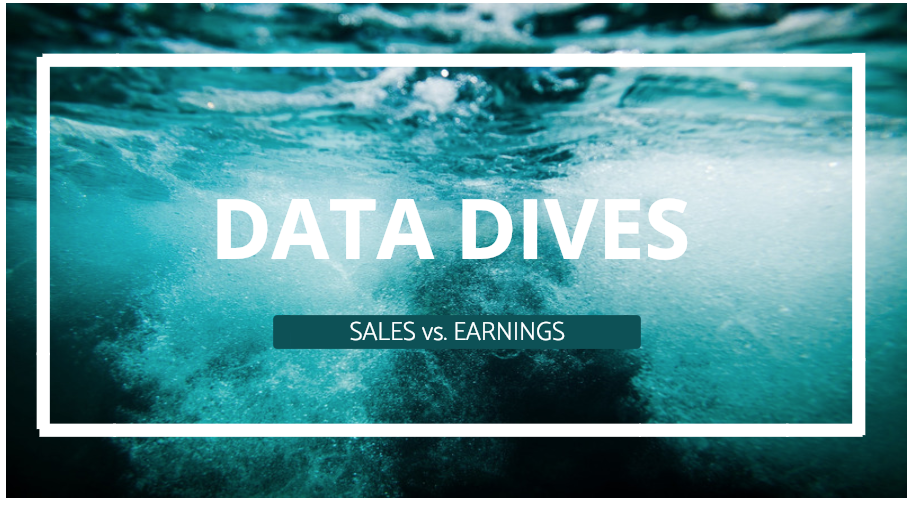CVSuite™ Data Dives are designed to help those using the CVSuite online data tool explore and put to work the wide array of data available in the tool. This month’s Data Dive focuses on the industry sales and earnings data. This blog will explain the difference between the data and the type of analyses that can be done with industry sales and earning data.
Industry sales data measure the amount of goods and services sold by creative industries. Industry earnings data measure the total amount of income that workers bring home from creative industries.
Question: What are the main differences between industry sales and earnings data? Which data is most appropriate for my analysis?
Users of the Creative Vitality Suite can access a quick glimpse of industry sales and earnings data directly on the dashboard of the tool.
To access more in-depth data, CVSuite users can visit Data Sets within the Data section on the main menu. Click on the Industry tab to view the data for earnings or sales.
Key Differences
While both the industry earnings and sales data are indicators of economic activity, they can impact the economy in different ways. The main difference between the two measurements is that industry sales data reflect the amount of goods and services sold within the specified region and do not always indicate dollars that will be retained within the local economy.
Once a good has been sold, external vendors must be paid–but these earnings may not be captured by the local economy. Some of that income may go to vendors from outside the region, thus it has no impact the local economy. Whereas industry earnings data reflect the total income that workers earn from creative industries within the region. There is a higher probability that local workers will spend their earnings within the region on necessities such as housing and transportation. The income earned by these types of workers will have a stronger impact on the economy than income that leaves the region.
Industry Sales
The industry sales data measure the revenue for goods or services sold within the region, such as paintings sold, tickets purchased for performances, or payment for a graphic design project. Sales are comprised of the amount of money that companies in a given industry receive during the year, minus discounts and deductions for returned merchandise. Within CVSuite, you can decide which industries to include in your analyses. The Industry Sales tab will display the amount of sales revenue and the number of jobs in each industry for the year you select.
In Colorado, software publishers were the largest contributing industry, with $7 billion in sales and 15,000 supported jobs. In this region, a majority of the industries with the most sales were industries with a focus on technology and information.
The independent artists industry was ranked the 6th largest industry in Colorado. Although the industry is much smaller than Colorado’s leading industry, software publishers, independent artists account for 30,000 jobs–almost twice as many jobs as software publishers. Overall, the total sales generated from all industries in Colorado were $26 million. You will see that sales provide a much larger value than earnings. With industry sales data, you can analyze some of your largest or smallest creative industries and assess the vitality they contribute to the local economy.
Industry Earnings
The industry earnings data measure the labor compensation paid to all of the workers in a given industry. The amounts are reported as average earnings per job for the most recent year of data only. The Industry Earnings tab includes the total earnings for a specific industry, number of jobs within that industry, average earnings per job, and the percentage change of earnings per job.
Some of the key data features to pay more attention to within the Industry Earnings tab include which occupation is earning the most within an industry and also the percentage change of earnings per job. In Colorado, the software publishers industry contributes the most in earnings. The average earnings in this industry is $139,000! The remaining creative industries are small in comparison to software publishers. The independent artists industry, for example, is ranked second among total industry earnings. We see that independent artists, on average, earn $20,000 annually. Knowing that this particular industry is right on the poverty line, an arts agency can assess the initiatives and programming that it offers to support artists, and which of those services could contribute to an artist’s earnings. Providing additional professional and business development to artists could help support those artists in the workforce and help them better understand the value of their creative services.
Conclusion
By gathering the industry earnings and sales data from the tool, you can acquire a better understanding of the creative economy overall. Using these data, you will be able to identify which industries are progressing every year and which are in decline. Analyzing industry earnings and sales data can allow you to see how your creative economy is growing. And if it is growing, you can gain deeper insight into which industries are contributing to that growth. The data in CVSuite can also help answer additional questions, including:
- What are the top three key creative industries that are contributing positively to my creative economy?
- Which creative industries do we need to focus our economic development efforts on?
- How much have this specific industry’s earnings grown year over year?
- What are the three-year trends for earnings and sales in a selected creative industry? What are the five-year trends?
Each month, the CVSuite team will highlight deeper dives within the CVSuite data and tool. Our goal is to help you best analyze the areas you are studying and to tell compelling and comprehensive data-driven stories.
We want to hear from you! If you have a specific question, please email us at cvsuite@westaf.org or call the CVSuite team at 303.629.1166.


Comments are closed.